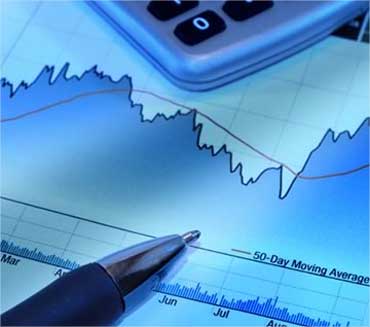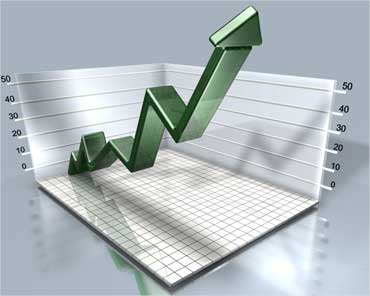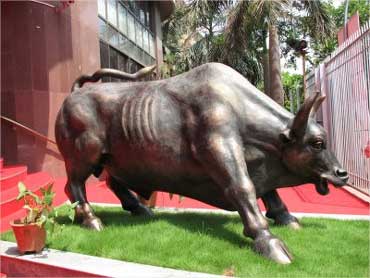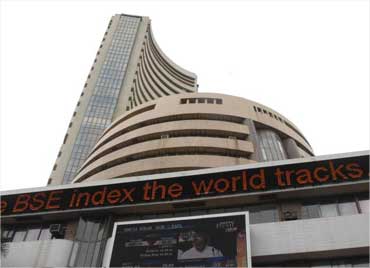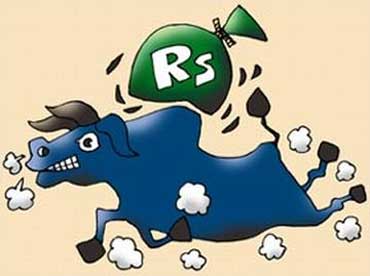 | « Back to article | Print this article |
How momentum helps you trade profitably
Momentum indicators are the building blocks of a trading system as they help us firm up trading strategies and entry and exit points from a trade. Here, master trader Ashwani Gujral outlines how you can use to make money in trading.
The classical chart patterns of technical analysis help us in identifying ongoing trends, trend reversals, and consolidation phases of the market.
Once you develop your visual inspection skills, you can easily identify the major trends by seeing the price charts.
However, you will often find it difficult to identify the smaller trends in this manner.
Let's take the example of a car traveling at some speed.
As an observer, you can make out that the car is moving with speed using your visual faculty.
But if the car slows down, say to avoid a pot-hole or to negotiate a bump, you will not be able to see it slowing down until its speed is noticeably slower.
On the other hand, a passenger sitting inside the car will be able to feel the car slow down.
Thus, when you are watching from the outside you can notice just the speed of the car but can't feel it slowing down.
Click on NEXT to read more...
How momentum helps you trade profitably
The person sitting inside the car, however, feels both the car's speed and also the car slowing down.
For you, it's akin to seeing the price pattern on charts but not the momentum; a passenger sitting inside the car sees both - the price pattern and momentum.
In technical analysis, momentum and rate of change (ROC) are two of the most commonly used terms.
They can be simply defined as technical indicators that show the difference between today's closing price and the close a certain number of days ago.
Momentum, thus, is simply the price difference (change) over a given time span.
How you can use momentum in conjunction with chart patterns
Momentum can be defined as the strength, or sustainability, of a market move as measured by both volume and price.
Click on NEXT to read more...
How momentum helps you trade profitably
A most commonly used, though not a very well understood, word in the trading world, momentum is the velocity of a trend or a price move.
As a technical analyst, our first task is to determine the ongoing trend.
Once the trend is known, we should then be able to successfully trade the trend in order to make money. This is the first use of indicators.
Another use of indicators is to try and determine when the trend may change, based on watching a combination of volume, price, and other indicators.
Obviously, this cannot always be accurately achieved because the trend can change according to the mood of the market but being aware of market statistics, positions of other traders, or any other significant change in the markets is always of benefit.
Momentum can be measured with the help of many indicators, such as rate of change (ROC), relative strength indicator (RSI), stochastic, and moving average convergence divergence (MACD).
Click on NEXT to read more...
How momentum helps you trade profitably
Interpretation of these momentum indicators is very important since all of them have some common characteristics but differ from one another in other aspects.
These indicators are typically plotted below the price chart and a first comparison can be made just by visual inspection.
It is always advisable to plot two or more indicators together in order to compare different momentum indicators on different time frames.
Different markets, different indicators
Momentum indicators can broadly be classified as:
- Trend following indicators, also known as lagging indicators, and
- Oscillators, also known as leading indicators.
Consolidating and trending markets are two different types of markets and require the use of different indicators:
- Trend following indicators, such as moving averages and MACD, are used in trending markets, whether up or down.
- They are also known as lagging indicators as they follow price movements and have lesser predictive ability.
Click on NEXT to read more...
How momentum helps you trade profitably
Since lagging indicators tend to focus more on the trend, they therefore produce fewer buy and sell signals.
This allows traders to capture more of the trend and remain in the trend by riding the big moves in trending markets instead of being forced out of their positions based on the more volatile nature of leading indicators.
A consolidating market is a sideways moving market that generally moves in a defined range with no particular bias whether up or down.
Oscillators, such as stochastic and RSI, confirmed with overbought and oversold levels are best suited for such markets.
Oscillators go up and down - they oscillate and are used to measure the momentum of a market or stock.
These oscillators are also known as leading indicators as they typically move ahead of the price and have some predictive qualities.
Click on NEXT to read more...
How momentum helps you trade profitably
They tell you ahead of time what might happen to prices. Oscillators are plotted within a bounded range and fluctuate into overbought and oversold conditions based on set levels for each particular oscillator.
Leading indicators create numerous buy and sell signals and are most suited for trading choppy (range bound) markets.
You should not use consolidating market oscillators in a trending market - or vice versa.
The choice of indicators to use should thus be made after assessing the nature of the market (up trend, down trend, or sideways), which you can do with the help of ADX.
You can also understand the difference between leading and lagging momentum indicators by considering the example of different Indian batsmen.
All our batsmen share one common attribute, i.e. each one has his own characteristics.
Of course, they all score runs (mostly!) but some take time to settle down (like VVS Laxman), while others start scoring the moment they reach the crease (like Sachin, Sehwag, Yuvraj, Dhoni and, occasionally, Ganguly), yet others build up their innings slowly and steadily (like Rahul Dravid), while some lag behind the others even more.
Click on NEXT to read more...
How momentum helps you trade profitably
Sehwag and company can be clubbed in the leading indicator category while Dravid and others can be clubbed as lagging indicators.
There are some batsmen who are useful for the 20-20 format others are more suited for one-day cricket while yet others for test cricket.
"Leading" batsmen are useful for 20-20 and one-day cricket (sideways markets or non-trending trading ranges) where quick scoring is required, while "lagging" batsman are most useful in test cricket (trending markets) which requires a slow build up of the innings with persistence and perseverance.
And just as a higher number of runs overall are scored in test cricket, similarly most of the big money is made during trending markets.
Leading indicators are akin to a live telecast where you can see the action in real time, feel the pulse of the game, its emotion, and the crowd behavior while lagging indicators are like watching a repeat telecast after the game is over, i.e. the indicator equivalent of hindsight.
Click on NEXT to read more...
How momentum helps you trade profitably
How momentum indicators provide profitable buy and sell signals
Indicators are used to develop buy and sell signals through:
- Crossovers,
- Oversold and overbought conditions, and
- Divergence.
A crossover is said to occur either when an indicator moves through an important level, or when one moving average crosses another moving average.
A crossover usually signals that the ongoing trend is shifting and this trend shift may lead to a certain movement in the price of the underlying stock or index as the case may be.
Divergence occurs when the direction of the price trend and the direction of an indicator's trend move in opposite directions.
This signals that the direction of the price trend may be weakening due to a change in the underlying momentum.
Momentum indicators are not used in isolation. Rather, they are used in conjunction with other tools of technical analysis, such as volume, chart patterns, candlesticks, etc.
Click on NEXT to read more...
How momentum helps you trade profitably
Just as cricket requires teamwork -- it's only when a majority of the players play well (are in agreement) that Team India wins -- so, too, when a majority of the indicators are in agreement we can safely say that a trend has reversed, resumed, or is confirmed as the case may be.
As is well-known, trends can also be classified as short term (3-6 weeks), intermediate (6-40 weeks), and long term (usually more than a year).
Thus, they can be likened to 20-over, 50-over and test match cricket, respectively.
Just as fortunes can turn very quickly either way in a short 20-over cricket match, in the markets, short term trend reversals similarly take much less time than is the case with long term trend reversals.
How to read momentum indicators
Indicators, as the name implies, indicate. Any analysis of an indicator should be taken with the price action in mind.
What is the indicator saying about the price action of a security? Is the price action getting stronger? Or, weaker?
Click on NEXT to read more...
How momentum helps you trade profitably
Momentum indicators are not infallible. Even though the buy and sell signals generated by the indicators may seem clear and obvious, such signals should be interpreted in confirmation with other technical analysis tools.
Momentum typically reverses along with the price - though the latter may do so with a small time lag.
It should not be taken for granted that just because oscillators have reversed, the price will also necessarily follow suit.
Just because Sachin Tendulkar has scored a century in a match does not mean that India will necessarily win the match. Others also have to pitch in to create a win.
Similarly, other technical tools should be used for confirming the signals given by indicators.
Momentum indicators, such as moving averages, MACD, RSI, and stochastic, are the building blocks of a trading system.
There is no single magic indicator; they all have their advantages and disadvantages.
It is important to be aware of both because we can then combine several indicators into a system to take advantage of their strengths, while their disadvantages cancel each other out.
[Excerpt from How to Make Money Trading With Charts by Ashwani Gujral and Prasanna Khemariya. Published by Vision Books.]
(C) All rights reserved.

